HESI Pharmacology Proctored Exam
HESI Pharmacology Proctored Exam
Total Questions : 46
Showing 10 questions Sign up for moreAfter taking orlistat for one week, a female client tells the home health nurse that she is experiencing increasingly frequent faty stools and flatus. Which action should the nurse take?
Explanation
Orlistat works by inhibiting the absorption of dietary fat in the intestines. The side effects of faty stools and flatus can be managed by reducing the intake of dietary fat. The nurse should ask the client to describe her dietary intake history for the last several days to determine if she has been consuming a diet high in fat.
Based on this information, the nurse can provide appropriate dietary advice to help manage these side effects.
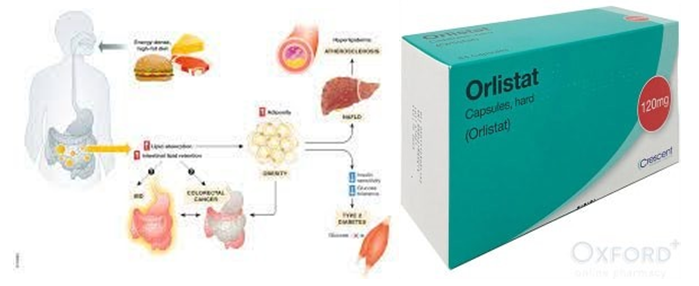
The nurse is preparing a discharge teaching plan for a clientwho is taking ciprofloxacin hydrochloride tablets which were prescribed because of a suspected anthrax exposure. Which instructions should be included in the teaching plan?
(Select all that apply.)
Explanation
The correct answer is:
a. Report any tendon pain or swelling to the healthcare provider immediately.
d. Limit exposure to sunlight and avoid tanning beds.
Choice A: Report any tendon pain or swelling to the healthcare provider immediately.
Ciprofloxacin, like other fluoroquinolones, can cause tendinitis and tendon rupture. This risk is higher in older adults, those on corticosteroid therapy, and those with kidney, heart, or lung transplants. Reporting any tendon pain or swelling immediately is crucial to prevent severe complications.
Choice B: Use NSAIDS to relieve mid joint aches and pains caused by the medication.
This is not recommended. Using NSAIDs with ciprofloxacin can increase the risk of central nervous system effects, including seizures. Therefore, it is not advised to use NSAIDs to relieve joint aches and pains caused by ciprofloxacin.
Choice C: Crush and mix the tablets with pudding if you have trouble swallowing the tablets.
Ciprofloxacin tablets should not be crushed. Crushing the tablets can affect the drug’s effectiveness and increase the risk of side effects. If swallowing is an issue, the healthcare provider should be consulted for alternative forms of the medication.
Choice D: Limit exposure to sunlight and avoid tanning beds.
Ciprofloxacin can increase the skin’s sensitivity to sunlight, leading to severe sunburns. Patients are advised to limit their exposure to sunlight and avoid tanning beds while taking this medication.
A client who is taking albendazole reports experiencing fatigue, nausea, and dark urine. The nurse observes a yellowing of the client’s skin and sclera. Which lab results should the nurse review?
Explanation
The client's symptoms suggest liver dysfunction, which is a known adverse effect of albendazole. Albendazole is primarily metabolized in the liver, and its use can cause liver damage in some cases. Therefore, it is essential to review liver function test results to assess the severity of liver damage and to determine if the medication should be discontinued or the dosage should be adjusted.
The renal function panel (a) measures the levels of various substances, such as creatinine and blood urea nitrogen, in the blood to assess kidney function.
The thyroid function test (b) evaluates the levels of thyroid hormones in the blood to diagnose thyroid disorders.
The basic metabolic panel (c) includes several tests that assess the levels of electrolytes, glucose, and other substances in the blood to evaluate metabolic function. However, these lab tests are not directly related to the symptoms and adverse effects associated with albendazole use
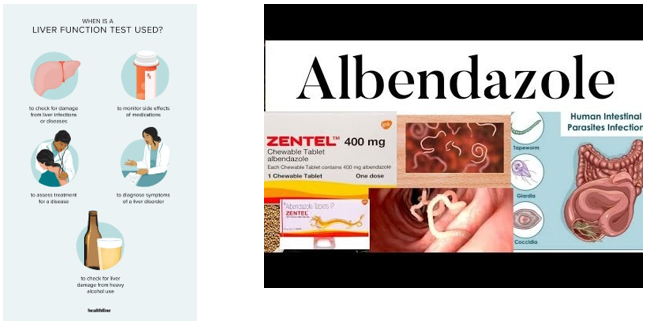
Which assessment data indicated to the nurse that a client is having an anaphylactic reaction to a medication?
Explanation
Anaphylaxis is a severe and potentially life-threatening allergic reaction that occurs rapidly after exposure to an allergen. The symptoms of anaphylaxis can vary but usually involve multiple organ systems, including the skin, respiratory, cardiovascular, and gastrointestinal systems.
Wheezing and dyspnea are two common symptoms of anaphylaxis that indicate the respiratory system's involvement.
Urticaria and pruritis are skin manifestations that can also be present in anaphylaxis, but they are not specific to this condition.
Insomnia and irritability are not typical symptoms of anaphylaxis.
Tinnitus and diplopia are also not common symptoms of anaphylaxis.
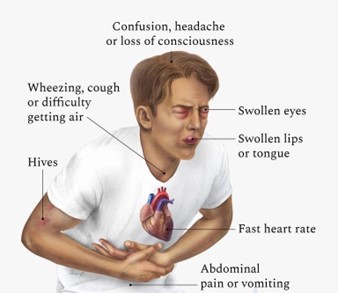
The nurse is planning to discharge teaching for a client with diabetes mellitus who has a new prescription for insulin glargine. Which action should the nurse include in the discharge teaching?
Explanation
Insulin glargine is a long-acting insulin that is given once daily at the same time every day via subcutaneous injection. Therefore, it is essential to teach the client self-injection skills for daily subcutaneous administration to ensure proper administration of insulin.
Option b is incorrect because insulin glargine is typically given at the same dose every day, not based on before meal blood sugar readings.
Option c is incorrect because insulin glargine is not used for the treatment of severe hypoglycemia, and it should not be administered by someone who is not trained to do so.
Option d is incorrect because ketoacidosis is a serious complication of diabetes mellitus that requires urgent medical atention, and increasing medication dosage is not appropriate for this condition.
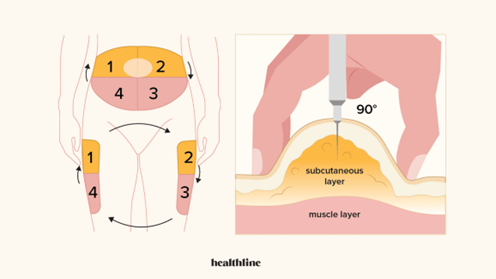
The nurse is preparing a client with Chronic Obstructive Pulmonary Disease (COPD) and a chronic productive cough for discharged home.
Which prescribed medication should the nurse review with the client to manage this symptom?
Explanation
Guaifenesin is an expectorant that helps to loosen and thin mucus in the airways, making it easier to cough up. It is commonly used to manage symptoms of a chronic productive cough in conditions such as COPD.
Salmeterol and Tiotropium are both bronchodilators that help to open up the airways and improve breathing in COPD, but they are not specifically indicated for managing a chronic productive cough.
Prednisone is a corticosteroid that can help reduce inflammation in the airways and improve breathing in COPD exacerbations, but it is not typically used for managing a chronic productive cough.
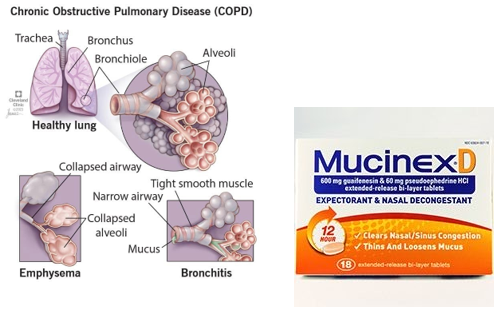
On admission, the healthcare provider describes a broad spectrum of antibiotic, ticarcillin for a client with a gram-negative infection. Before administering the first dose, it is most important for the nurse to implement which prescription?
Explanation
Before administering the first dose of any antibiotic, it is essential to obtain a culture and sensitivity test to identify the causative organism and determine the most effective antibiotic to use. Administering a broad- spectrum antibiotic before obtaining a culture and sensitivity test may lead to the development of antibiotic-resistant strains of bacteria, making it more difficult to treat the infection in the future.
Options a, c, and d are not as important as obtaining a culture and sensitivity test. Monitoring for signs of sodium and fluid retention, irrigation and topical antibiotic application to the wound area, and completing blood count and serum electrolytes are important, but obtaining a culture and sensitivity test is the priority.
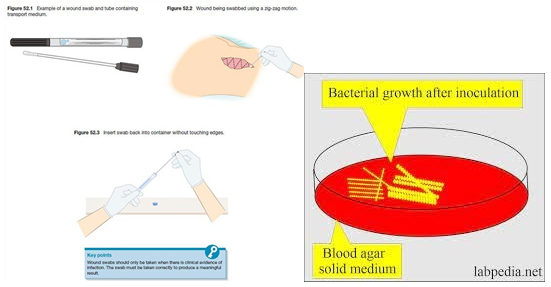
The nurse is planning care for a patient with major depression who is receiving a new prescription for duloxetine.
Which information is most important for the nurse to obtain?
Explanation
The correct answer is C. Liver function lab results.
Choice A: Weight change in the last month
Weight change is a relevant factor to monitor in patients starting on antidepressants, including duloxetine, as some antidepressants can cause weight gain or loss. However, it is not the most critical information to obtain initially. Monitoring weight can help manage potential side effects and ensure the patient’s overall health, but it does not directly impact the immediate safety and efficacy of starting duloxetine.
Choice B: Recent use of other antidepressants
Recent use of other antidepressants is crucial information because combining duloxetine with other antidepressants, especially MAOIs (Monoamine Oxidase Inhibitors), can lead to serious interactions such as serotonin syndrome. This condition can be life-threatening and requires careful management. However, while this information is important, it is not as immediately critical as liver function tests when starting duloxetine.
Choice C: Liver function lab results
Liver function lab results are the most important information for the nurse to obtain. Duloxetine is metabolized in the liver, and patients with pre-existing liver conditions or impaired liver function are at higher risk for hepatotoxicity. Monitoring liver function is essential to prevent severe liver damage, which can be life-threatening. Baseline liver function tests help ensure that the patient can safely metabolize the medication and identify any potential issues early.
Choice D: Family history of mental illness
Family history of mental illness can provide valuable context for understanding the patient’s condition and potential genetic predispositions. It can also help in tailoring the treatment plan and anticipating the patient’s response to medication. However, while this information is useful for long-term management, it is not as immediately critical as liver function tests when initiating duloxetine therapy.
An older adult client with restless legs syndrome begins taking melatonin at bedtime. When evaluating the effectiveness of the herb which client assessment should the nurse complete?
Explanation
Restless legs syndrome is a condition that causes an uncomfortable sensation in the legs and an uncontrollable urge to move them. Melatonin is a natural hormone that helps regulate the sleep-wake cycle and can be used as a sleep aid. Therefore, when evaluating the effectiveness of melatonin in an older adult client with restless legs syndrome, the nurse should assess the client's sleep patterns to determine if the herb is improving their ability to fall and stay asleep.
Assessing anxiety level (a) may be useful in other contexts, but it is not directly relevant to evaluating the effectiveness of melatonin for restless legs syndrome. Observing for peripheral edema (b) and palpating pedal pulse volume (d) are important assessments in clients with peripheral vascular disease or other circulatory disorders, but they are not directly related to restless legs syndrome or the use of melatonin.

Before administering initial dose of sumatriptan succinate to a client with a migraine headache, it is most to determine if the client’s history includes which problem?
Explanation
Sumatriptan succinate is a medication used to treat migraine headaches by narrowing blood vessels in the brain. It is important to determine if the client has a history of coronary artery disease before administering the initial dose because the medication can also cause narrowing of the coronary arteries and potentially lead to a heart attack or other cardiac events.
Type 2 diabetes mellitus (a), seasonal allergic rhinitis (c), and irritable bowel syndrome (d) are not directly related to the use of sumatriptan succinate. However, it is still important to consider the client's medical history and overall health status when prescribing or administering any medication.

You just viewed 10 questions out of the 46 questions on the HESI Pharmacology Proctored Exam Exam. Subscribe to our Premium Package to obtain access on all the questions and have unlimited access on all Exams. Subscribe Now



